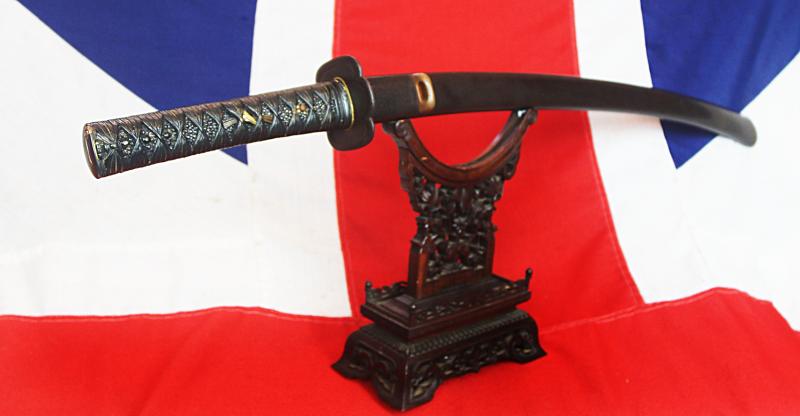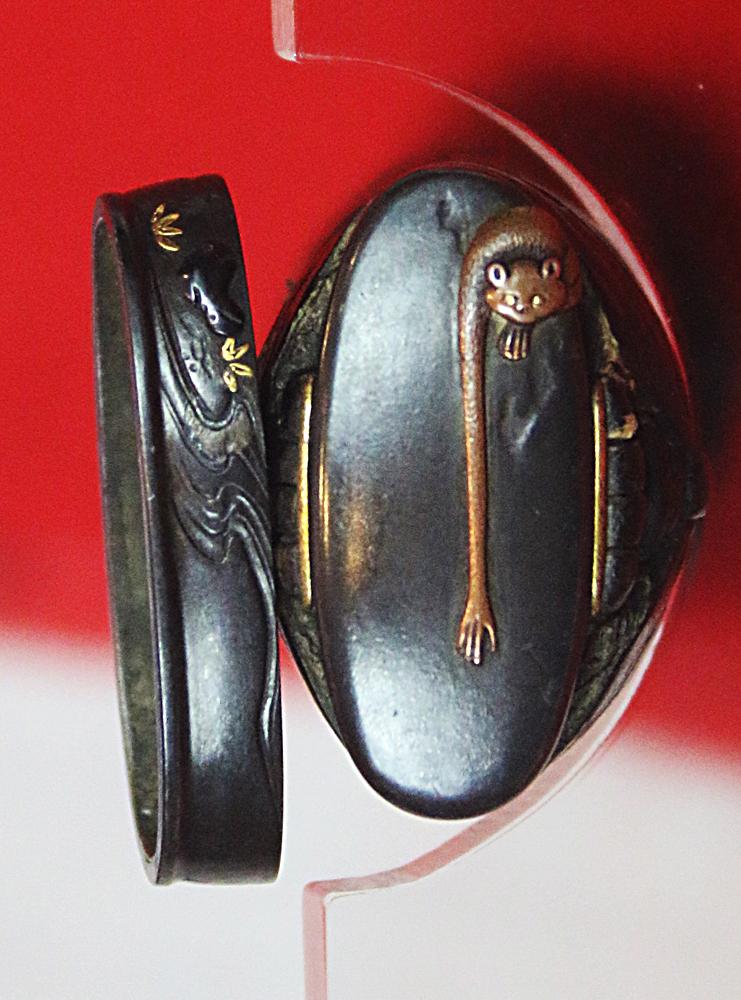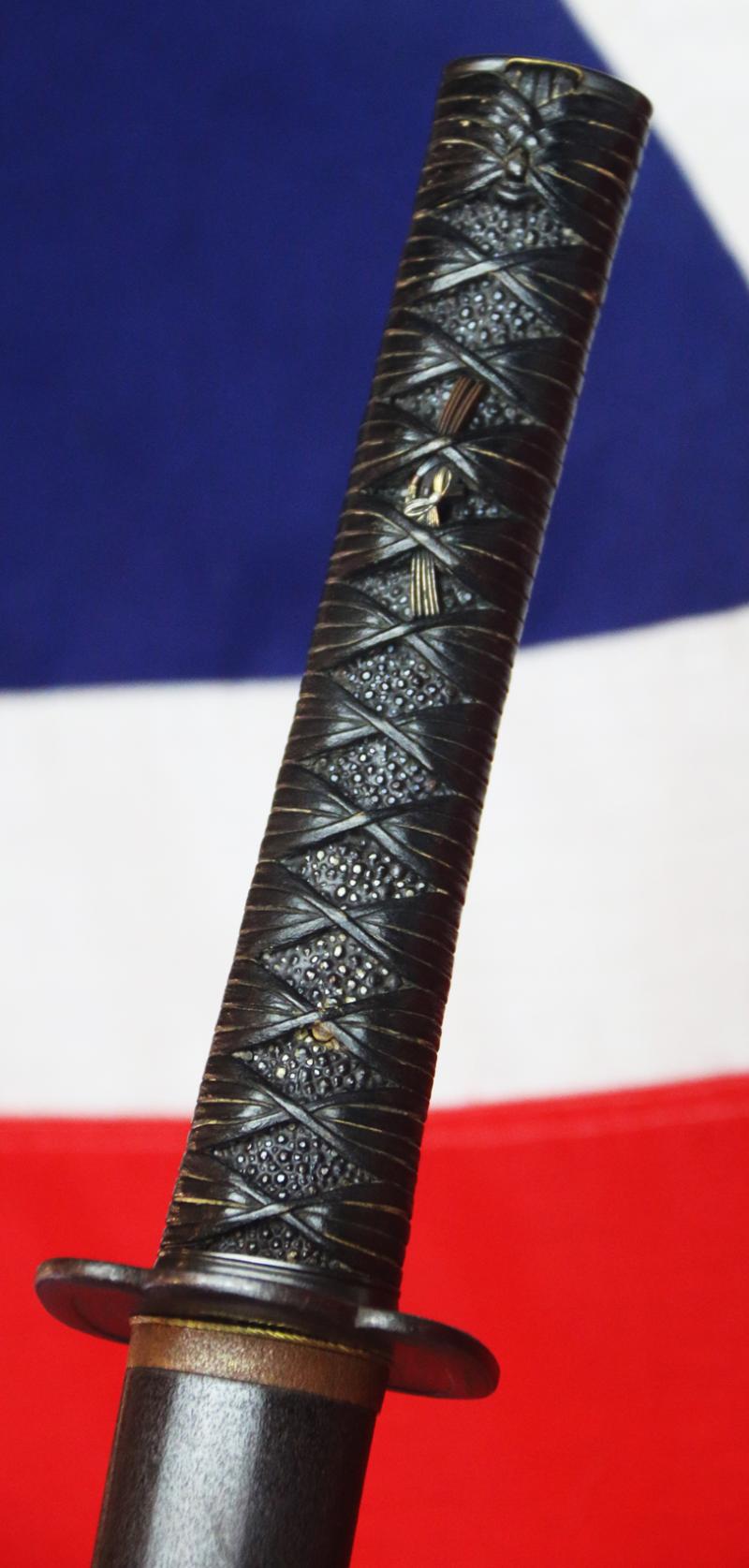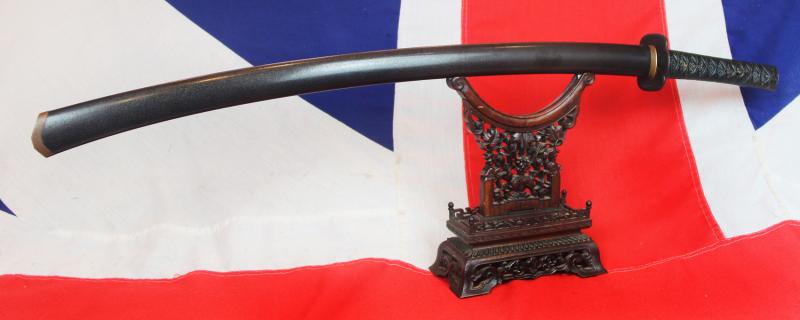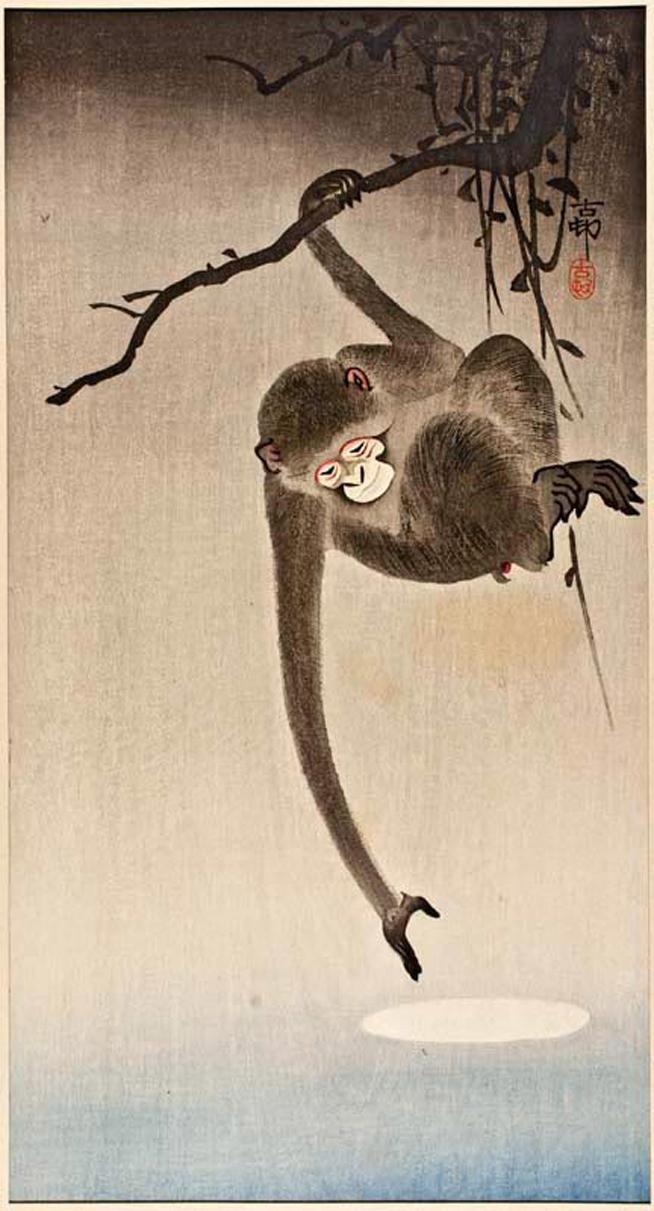A Very Beautiful & Incredibly Elegant Koto Katana Art Sword Circa 1500, With Very Fine All Original Edo Koshirae, of Finely Decorated Shakudo, Combined With Exceptional Urushi Lacquer Work. Kashira Decorated with ‘The Monkey Reaching for the Moon’
Very fine original Edo period fittings, mokko gata tsuba and saya. Shakudo fuchi-kashira, decorated with a wonderfully defined little long armed monkey reaching for the moon's reflection in a stream. The long armed monkey is on the kashira, the stream is represented on the fuchi. ‘The Monkey Reaching for the Moon’, fuchi-kashira, depicts a delightful little monkey hanging from a tree branch over the surface of water, reaching down to touch the reflection of the moon. This imagery is undoubtedly derived from a popular Buddhist story that warns how the spiritually unenlightened cannot distinguish between reality and illusion. We very rarely get swords with fittings decorated with the fable of 'the monkey reaching for the moon', but by most unusual good fortune, we have had two this month.
Shakudo and gold menuki of artistically bound reeds, with a fine mokko-shaped Higo school iron tsuba with a raised mimi {edge}, and a black beautiful ishime urushi lacquered saya with matching copper ishime koiguchi, kurikata and kojiri, {scabbard mountings}.
It has a very beautiful 25.25 inch blade, measured tsuba to tip, Typical Koto style and period, an extremely elegant blade with fine graduation, beautiful curvature and iconic Koto form small kissaki It has a superb complex hamon of a choji and crab-claw pattern.
Some provinces of Japan were famous for their contribution to the ishime style of urushi lacquer art: the province of Edo (later Tokyo), for example, produced the most beautiful lacquered pieces from the 17th to the 18th centuries. Lords and shoguns privately employed lacquerers to produce ceremonial and decorative objects for their homes and palaces.
The varnish used in Japanese lacquer is made from the sap of the urushi tree, also known as the lacquer tree or the Japanese varnish tree (Rhus vernacifera), which mainly grows in Japan and China, as well as Southeast Asia. Japanese lacquer, 漆 urushi, is made from the sap of the lacquer tree. The tree must be tapped carefully, as in its raw form the liquid is poisonous to the touch, and even breathing in the fumes can be dangerous. But people in Japan have been working with this material for many millennia, so there has been time to refine the technique!
Flowing from incisions made in the bark, the sap, or raw lacquer is a viscous greyish-white juice. The harvesting of the resin can only be done in very small quantities.
Three to five years after being harvested, the resin is treated to make an extremely resistant, honey-textured lacquer. After filtering, homogenization and dehydration, the sap becomes transparent and can be tinted in black, red, yellow, green or brown.
Once applied on an object, lacquer is dried under very precise conditions: a temperature between 25 and 30°C and a humidity level between 75 and 80%. Its harvesting and highly technical processing make urushi an expensive raw material applied in exceptionally fine successive layers, on objects such as bowls or boxes, or as you see, samurai sword saya {scabbards}. After heating and filtering, urushi can be applied directly to a solid, usually wooden, base. Pure urushi dries into a transparent film, while the more familiar black and red colours are created by adding minerals to the material. Each layer is left to dry and polished before the next layer is added. This process can be very time-consuming and labour-intensive, which contributes to the desirability, and high costs, of traditionally made lacquer goods. The skills and techniques of Japanese lacquer have been passed down through the generations for many centuries. For four hundred years, the master artisans of Zohiko’s Kyoto workshop have provided refined lacquer articles for the imperial household. It is extraordinary that a finest urushi lacquer saya would have taken up to, and over, a year to hand produce, by some of the most finely skilled artisans in the world.
Shakudo {that can be used to make samurai sword mounts and fittings} is a billon of gold and copper (typically 4-10% gold, 96-90% copper) which can be treated to form an indigo/black patina resembling lacquer. Unpatinated shakudo Visually resembles bronze; the dark colour is induced by applying and heating rokusho, a special patination formula.
Shakudo was historically used in Japan to construct or decorate the finest katana fittings such as fuchi-kashira, tsuba, menuki, and kozuka; as well as other small ornaments. When it was introduced to the West in the mid-19th century, it was thought to be previously unknown outside Asia, but recent studies have suggested close similarities to certain decorative alloys used in ancient Egypt, Greece, and Rome.
The above descriptions show just why the finest Japanese fully mounted swords can be referred to as ‘Art Swords’, not because they were made just to be items of incredible beauty, to admire and revere, but also, as usable, everyday use swords to be worn by highest status samurai and clan lords, that are also statements of the status of the wearer, as well as of the finest beauty and artistic merit. The blade is absolutely beautiful, with just small elements of natural age surface thinning at the top quarter on one side.
Blade 25 inches long tsuba to tip, overall in its saya, 33.6 inches long
Code: 25351
7450.00 GBP


